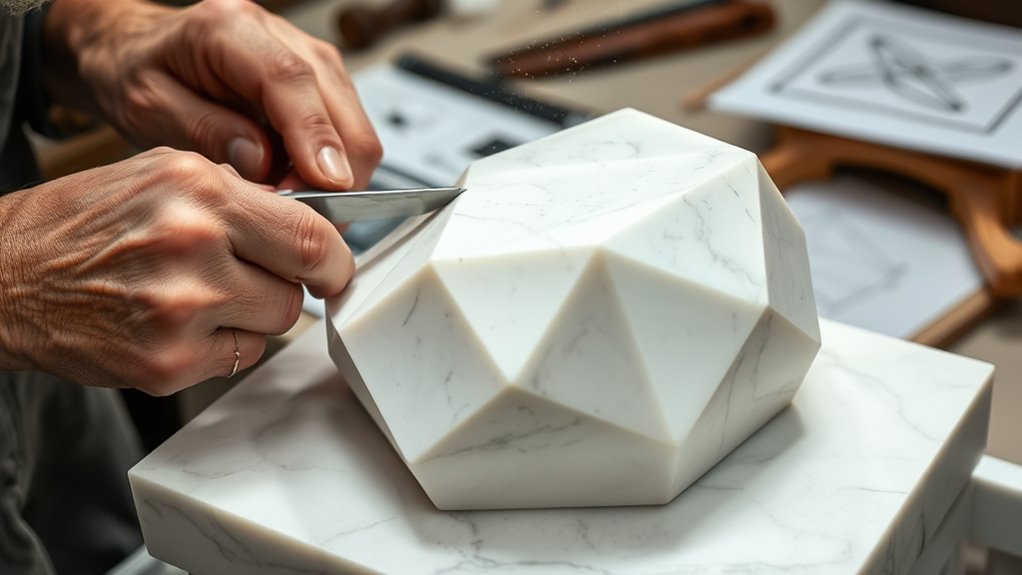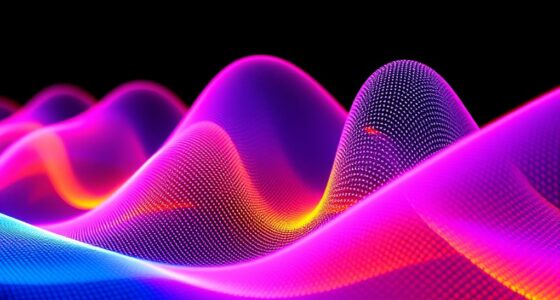As a sculptor, you see geometry as the foundation for shaping perception, guiding construction, and expressing ideas through precise spatial relationships. It influences how forms interact, creating movement, tension, and harmony within your work. Geometry helps you balance abstract shapes, evoke emotions, and communicate concepts beyond literal representations. If you explore further, you’ll discover how this mathematical language profoundly shapes not only your sculptures but also how viewers experience them.
Key Takeaways
- Geometric principles shape sculpture perception, influencing form, space, and emotional response.
- Sculptors manipulate basic shapes to explore spatial relationships and dynamic compositions.
- Geometry guides viewer interaction, creating movement, tension, and varied perspectives.
- Precise geometric arrangements evoke harmony or dissonance, enhancing conceptual communication.
- Understanding craftsmanship reveals the thoughtful geometric planning behind intricate sculptural forms.

Geometry forms the foundation of many sculptural works, shaping how you perceive form, space, and proportion. When you step into a gallery or stand before a sculpture, it’s the geometry that guides your understanding of what you see. You notice how abstract forms come together, creating a visual dialogue that challenges traditional representations. These forms aren’t just random; they’re carefully constructed using geometric principles that influence your emotional and intellectual response. You might see a piece that seems chaotic at first glance, but as you focus, you recognize the precise relationships between different parts, revealing a hidden order. This is where the concept of spatial relationships becomes vital. The artist intentionally manipulates space, making some areas appear closer or more distant, larger or smaller, to evoke specific feelings or ideas. You’re drawn into this spatial play, experiencing the sculpture not just visually but physically, as your eyes follow the flow and intersections of abstract forms. Additionally, understanding geometric principles enhances your appreciation of how sculptors create balance and tension within their works.
Understanding the role of geometry helps you appreciate how sculptors use it to communicate complex concepts. For example, by employing basic shapes like spheres, cubes, or cones, the artist establishes a visual language that feels familiar yet innovative. These shapes can be manipulated—stretched, compressed, or intersected—to explore new spatial relationships. As you observe, you realize that the arrangement of these forms affects how you move around the sculpture, encouraging different perspectives and interpretations. The geometry isn’t static; it’s dynamic, creating a sense of movement and tension within the work. You feel this energy as your gaze shifts across the sculpture’s surface, noticing how the abstract forms interact to create rhythm and balance.
Moreover, the precision in the geometric layout guides your eye and mind through the sculpture, emphasizing harmony or dissonance depending on the artist’s intent. When the forms are in perfect proportion, your senses experience a sense of stability and order. Conversely, when proportions are intentionally skewed, you feel a tension that invites deeper reflection. This deliberate manipulation of spatial relationships and abstract forms allows the sculptor to communicate ideas that transcend literal representations, making their work resonate on a more conceptual level. Ultimately, understanding how geometry shapes these aspects enables you to see beyond the surface, appreciating the intricate craftsmanship and thought process behind every curve, intersection, and void within the sculpture.
Frequently Asked Questions
How Does Geometry Influence Emotional Expression in Sculpture?
Geometry shapes emotional resonance in sculpture by guiding your perception of abstract forms. Sharp angles can evoke tension or energy, while smooth curves inspire calmness. When you engage with these geometric elements, you feel the artist’s intended emotional expression more deeply. Clever use of proportions and spatial relationships creates a powerful connection, allowing you to experience a visceral response. Ultimately, geometry helps sculptors communicate complex feelings through visual abstraction.
What Are the Most Challenging Geometric Forms to Sculpt?
You find that organic contours and complex polyhedra are the most challenging forms to sculpt. Organic contours flow naturally like rivers or wind-blown leaves, demanding delicate precision. Complex polyhedra, with their sharp edges and intricate faces, test your technical skill and patience. Mastering these forms pushes your creativity, forcing you to balance precision with spontaneity for a compelling, lifelike sculpture.
How Do Cultural Differences Affect Geometric Choices in Art?
You’ll find that cultural differences crucially influence geometric choices in art, as they reflect cultural symbolism and aesthetic preferences. For example, some cultures favor symmetrical, balanced forms symbolizing harmony, while others prefer more dynamic, asymmetrical shapes representing vitality. Your understanding of these cultural nuances helps shape your sculptures, ensuring they resonate with viewers from diverse backgrounds and communicate deeper meanings rooted in specific cultural contexts.
Can Geometry Be Used to Enhance Viewer Interaction With Sculptures?
Yes, geometry can enhance viewer interaction with sculptures by creating engaging forms that invite exploration. You can use geometric shapes and patterns to stimulate interactive engagement, encouraging viewers to move around and perceive different perspectives. Thoughtfully designed geometric elements help shape viewer perception, making the sculpture more dynamic and inviting. By carefully considering geometric principles, you can craft sculptures that actively draw viewers in and foster a deeper connection.
What Tools or Technology Assist in Translating Geometric Concepts Into Sculpture?
You use digital modeling software like Rhino or Blender to translate complex geometric concepts into precise designs. These tools let you experiment with forms and proportions before physical creation. Laser cutting then takes your digital models and accurately cuts or engraves materials, turning your geometric ideas into tangible sculptures. This combination streamlines the process, ensuring accuracy and allowing you to focus on artistic expression within the geometric framework.
Conclusion
As you continue exploring the world of sculpture, remember that geometry gently guides your creativity, offering subtle hints rather than strict rules. Embrace its quiet influence, allowing it to shape your ideas with grace and elegance. When you let these silent principles inspire you, your work becomes a harmonious dance between form and space. Ultimately, it’s in these delicate balances that true artistic beauty quietly resides, waiting for you to discover its subtle whispers.









